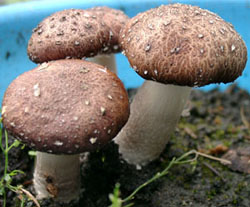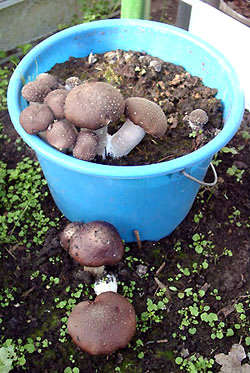|
The brown stew fungus or wine-red stropharia is easily mixed up with the bay bolete (Boletus badius, syn. Xerocomus badius). However, the latter as with the Boletus mushroom too, cannot be grown in the garden.
Fortunately the brown stew fungus (Stropharia rugoso-annulata) is fairly easy to grow.

Brown stew fungus ready to harvest
It is native to Central Europe and appears mainly in the Summer and Autumn months as groups of mushrooms on mulch, rotting straw and wood. It has a nearly classical appearance and is often likened to the bay bolete but unfortunately it is not half as tasty.
The brown stew fungus has a brown cap, and the young fruiting body tends to be rough and hemispherical in shape. It flattens out later, when it can be rough or smooth on the outside.
The cap can have a diameter of up to 10 cm (sometimes even up to 20 cm). It usually grows in clusters or bunches which can be accompanied by smaller mushrooms too (for example latecomers after the main harvest). The lamellae (or gills) are initially grey and turn to dark violet later. The stalk is a light colour and thick and can grow to a length of up to 10 cm with large mushrooms. The best time to harvest is when the cap has the shape of a bell. The mushroom should then be twisted and pulled out of the substrate together with the stalk.
At the beginning of the 60's of the last century, the mushroom and the possibility of cultivating it was discovered largely by chance. Potatoes were being stored on the Karlshorster Rennbahn (race track) in East Berlin by covering them up with straw. After opening the covered piles of potatoes, the straw was pushed to one side and the original strain of the brown stew fungus appeared on these “rubbish piles” regularly as giant mushrooms and in large quantities. The "VEG Champignonzucht" in Dieskau (GDR state-owned enterprise) then started to grow them for sale on the market and bred the current variety which was slightly smaller.

Brown stew fungus on sawdust in a bucket with no bottom.
The mushrooms have even "escaped" to the surroundings.
You can grow the brown stew fungus on straw, i.e. straw bales or chopped straw. You can also grow it on shredded shrubs or bushes from deciduous wood.
The brown stew fungus need contact with the soil. If you want to try it on chopped straw, you could enclose the substrate within a frame or put the mixture of straw and spawn into a bucket with the bottom cut out. You can then cover this with a few branches or twigs to provide a bit of shadow. When the mycelia has grown well into the straw, you should cover it up with a thin layer of soil (so-called casing soil.
Click here to get further instructions.
if you want to grow it in a greenhouse make sure that the substrate temperature does not exceed 35°. So you should not try to grow this mushroom in a greenhouse in the middle of the Summer.
Profile of the wine-red stropharia mushroom |
Taste and preparation:
We recommend you to harvest this mushroom early, i.e. before the cap has opened up. If you wait too long for the harvest, the spores can colour the washing water dark brown. If you eat the mushroom raw, there are reports that it tastes a bit like radish. It also tastes a bit nutty when cooked. You can also cook most of the stalk.
The advisory board of the Deutschen Gesellschaft für Mykologie (DGfM, German Society of Mycology) has received several reports of intolerance to eating this mushroom. |
Production and marketing:
Nowadays, this mushroom has no commercial significance. |
Growing in the garden:
Easy to grow on straw bales.
|
Our products:
Spawn for brown stew fungus |
|